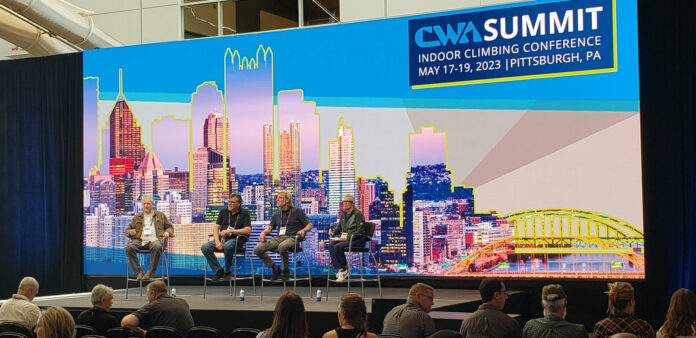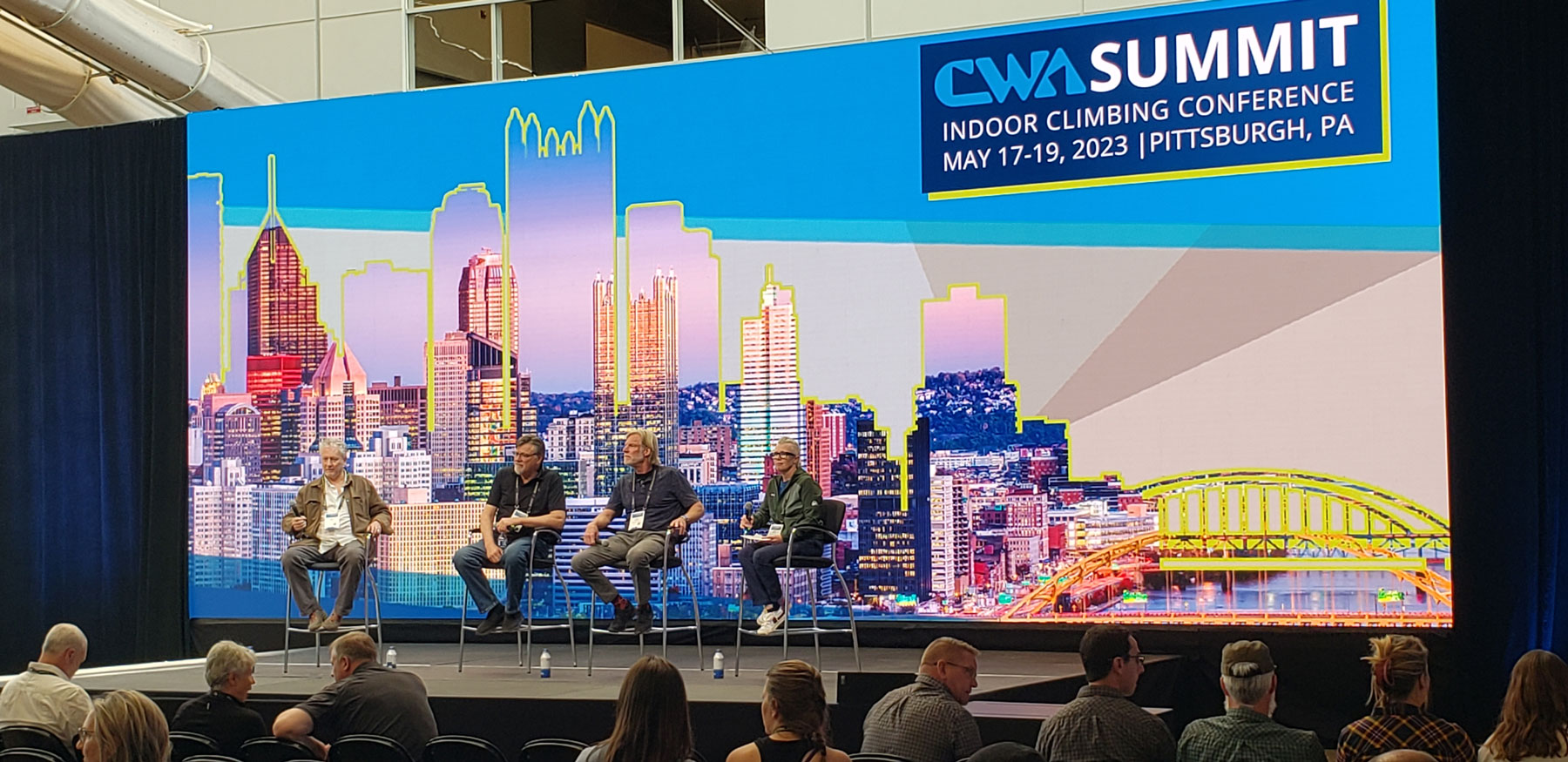
The climbing industry’s big week has come and gone, and the buzz was not overhyped. Over 40 educational sessions were held at the 2023 CWA Summit for climbing gym professionals convening from around the world, and more than 70 brands displayed their latest must-see products and innovations. Around the packed Summit days in Pittsburgh, the city was bustling with more climbing events: The first CWA Intro to Routesetting course on commercial setting took place at nearby FA Station Square; 18 routesetters put their skills to the test at ASCEND South Side for the most recent Setter Showdown; and 28 branded routes at Iron City Boulders showcased some of the hottest grips on the market as part of the CBJ Grip Showcase Pittsburgh. (Not to mention the events in Salt Lake City, where 114 paraclimbing athletes and 251 climbing athletes from 37 countries competed at the IFSC World Cups during that same week).
Like last year, we wanted to bring you some highlights from the Summit by sharing first-hand observations from attendees on the floor. The responses below come from professionals who have been in the industry for decades, riding the ups and downs that come with a maturing industry. Their words are a reminder that the climbing gym industry is still on a fast-moving upward trajectory, routesetters (and all staff) are core to long-term success, there’s still room to learn from neighboring businesses and industries, and empathy is essential to good leadership.
- The Climbing Industry Continues to Glow Red Hot by Erik Lambert
- Routesetting and Collaboration Go Hand in Hand by Foxman McCarthy-James
- There’s Always Room for Improvement by Gavin Heverly
- Staff Retention Requires Empathetic Leadership by Scott Rennak
The Climbing Industry Continues to Glow Red Hot
By Erik Lambert
The CWA Summit is the must-attend national event for the indoor climbing industry. The trade show annually hosts more than 1,000 climbing gym owners, managers, routesetters and other staff as well as related vendors (think wall manufacturers, hold companies, hard and soft goods, software, nonprofits, and basically anything else that has to do with indoor climbing). The community comes together for three very full days and nights to network, share and learn from one another, and to generally discuss the future of the industry. And party.
This year the conference was held among the skyrises of Pittsburgh, Pennsylvania. Maybe you’re reading this and having the same initial reaction I did (alongside many other attendees): “Pittsburgh…What?!” The location was a departure from previous shows, which traditionally were hosted in Colorado and then last year in Utah.
It didn’t take long to settle into the Steel City, though. Pittsburgh now sports four modern full-service gyms in the downtown area; for many on the East Coast, the ability to drive to the Summit was a refreshing change; the tacos and pierogies were on point; and the venue (David L. Lawrence Convention Center) is airy and full of light. It rocks a massive roof deck, big views across the rivers, and swooping modern architecture nestled among surrounding historic buildings.

My main takeaway from this year’s conference: the indoor climbing world is in rapid expansion mode. The collective energy was optimism and excitement…paired with the growing pains that accompany uncharted territory.
While I’ve been in the climbing world for 17 years, this was my first time attending the CWA Summit. I enjoyed meeting folks from all over the country and found the conference worth the trip from Colorado. As a marketing agency owner looking to partner with gyms, my main goal was to better understand the overall state of the industry as well as gym leadership mindsets. So, most of the educational sessions I attended were designed for gym executives or marketers and were focused on growth. In that arena, here’s where the energy was buzzing:
1. Expansion Is the Focus
In short, the indoor climbing industry continues to glow red hot. There is a not-so-secret race to build out locations, especially in major metropolitan areas, and capture the market before someone else does.
The pendulum is swinging hard out of pandemic doldrums. I barely heard COVID mentioned at the conference aside from visitation slowdowns in commuter locations. Most everywhere else, climbing gym visitation is back to pre-pandemic levels and growing. The slower months when gyms were closed, or barely open, introduced a window for owners to plan their next moves. And they’re making them. I spoke with or heard from about 20 gym owners at the show. Almost all of them actively have plans to build new locations, increase the footprint of their existing gyms, acquire their competition—or get acquired.
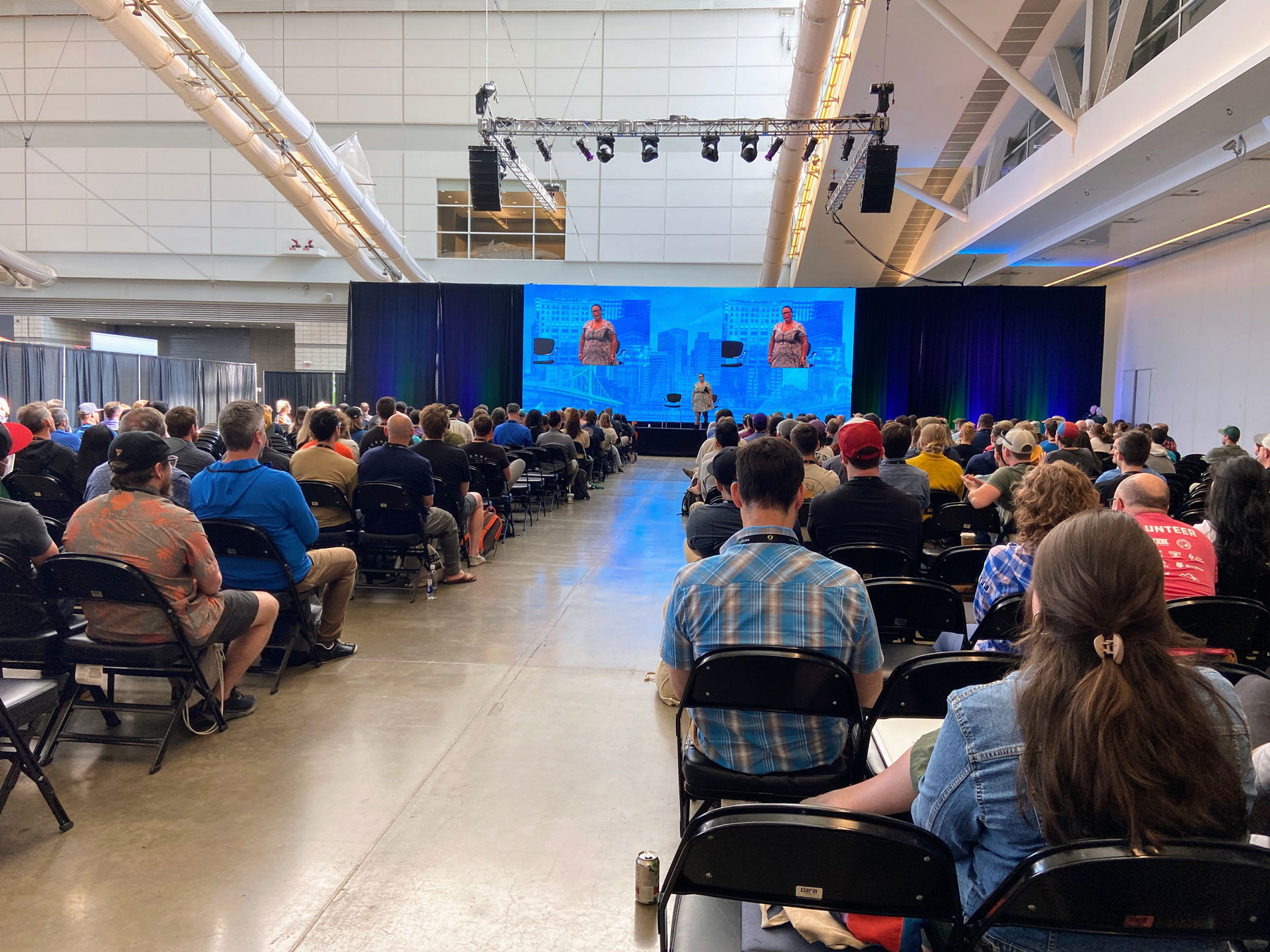
Not every owner is on this path, and some are skeptical of industry consolidation. However, private equity entering the equation and making rapid moves to build and acquire has accelerated these conversations. In a gym owners’ roundtable, the moderator took a straw poll of how many owners intended to sell in the next three years; about 20% of hands went up. Mike Moelter, co-founder of Movement who made a majority exit to El Cap (now Movement) in 2019, explained that he started volunteering behind the desk at a climbing gym in 1995 just to be part of the scene. “Taking the business to sale was the way to get to the finish line on the original dream—to make a life out of the climbing gym industry.”
2. Yet Collaboration Is Strong
Even as many brands vie for pole positions in competitive markets, the Summit spirit is friendly and collaborative. It’s a small industry, after all, yet organized enough to host a national show where curiosity is welcome and no topic is taboo.
“This industry used to be super secret,” says Kenneth Cronin, a 28-year industry veteran and owner of Crag X Indoor Climbing Centres. “We’d do things like try to hide our belay tests from each other. But we have a lot more in common than reasons to compete or steal from each other.”
Every attendee I met was open to sharing, and educational sessions revealed “under-the-hood” information. For example, I learned that the average cost to acquire a new member through digital advertising is $118. I downloaded detailed instructions on how to leverage gym equity to self-fund expansion. And I got the rundown on all of Triangle Rock Club’s membership initiatives and incentives (my favorite nugget: they send handwritten postcards to anyone who’s checked in 50 times, gotten lead belay certified, or frozen their membership due to injury, to name a few). The only times I heard someone decline answering a question, it was about specific locations of forthcoming gyms or a price of sale.
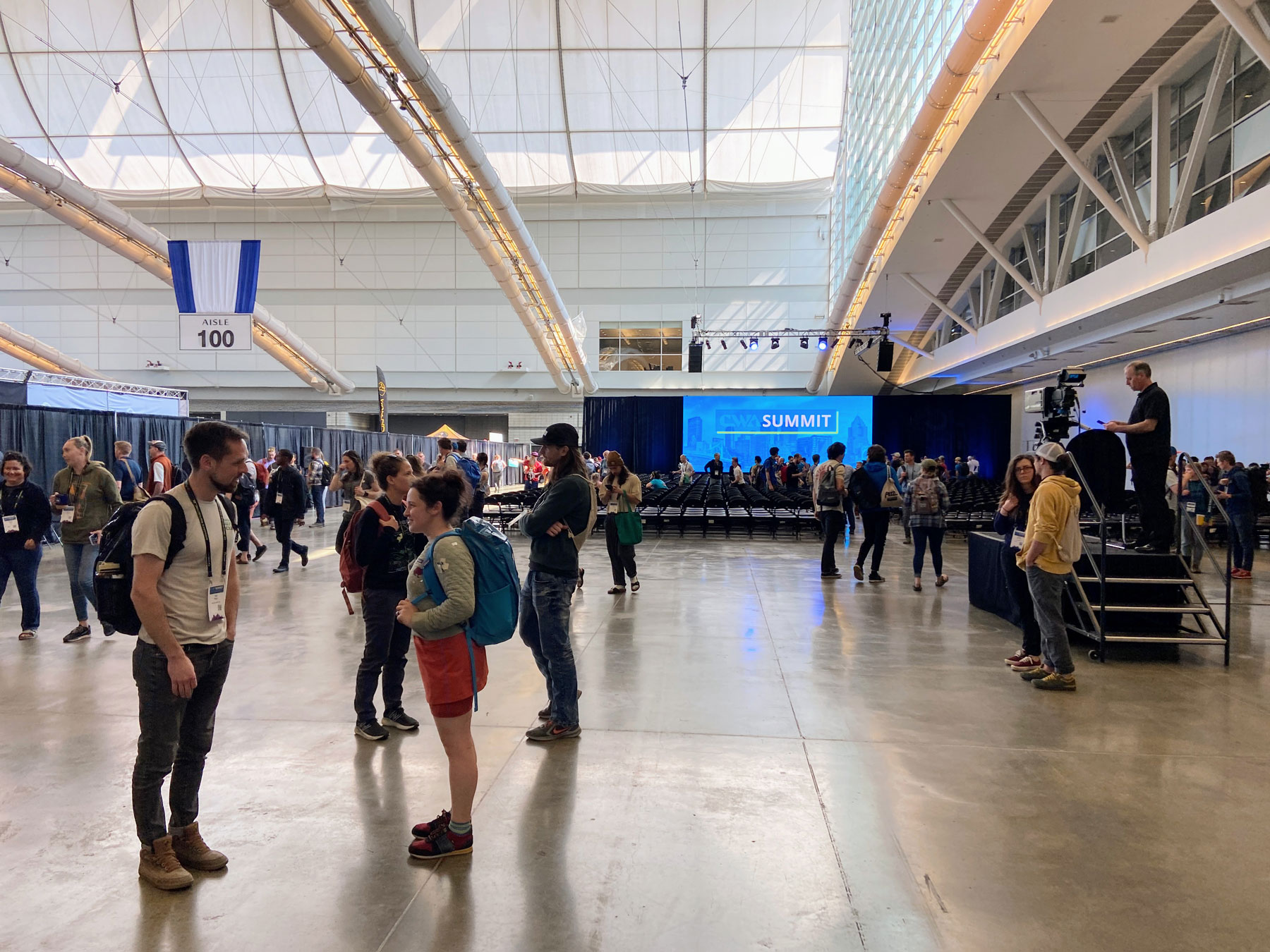
The CWA was founded 20 years ago not just to share beta like this but also to collectively solve industry challenges. Securing insurance and proactively establishing national standards were the early initiatives, and the value of network coordination remains important today. Recently, a collection of gyms in the Pacific Northwest formed a nonprofit organization called the Washington Indoor Climbing Coalition; alongside the CWA legal team, this new organization is fighting a surprising new amusement park designation that would require expensive and never-before-requested safety certifications.
3. Acceleration Is Inspiring Staff Development
With growth comes new difficulties. One of the major themes I heard was the challenge and opportunity to reshape staff development. With multiple locations, gyms can more easily scale functions of the business, like routesetting and marketing. And as gyms become bigger businesses, they also improve the potential to retain and grow staff from one role into the next.
“You’re not just expanding your facility; you’re expanding the people who work for you,” said Lillian Chao-Quinlan, Executive Chair of Sportrock Climbing Centers. “In the infinite game, how do I scale and create a runway for employees to continue growing their skillset and establish a career?”
Owners, too, are rethinking their roles. On more than one occasion in the “Lessons Learned From Multi-Gym Owners” panel, I heard the mantra of needing to work on their business rather than in their business. Whether focusing on fundamentals or scaling those fundamentals across locations, owners realize they can be their own worst enemy if they are micromanaging their team.
In that same panel, the final question came from a 30-year-old gym owner who asked the older guard: “Is there more or less opportunity today for growing a business such as yours?”
Jeffery Bowling, Creative and Business Development Director for Touchstone Climbing, answered. “It’s a totally different ballgame. There is probably not game-changing innovation happening now… but climbing is on a whole other level. 12,000 square feet used to be insane, huge—but there was none of this,” he said, pointing around the room. “There was no such thing as an opportunity to be here and learn from everyone.”
About the Author
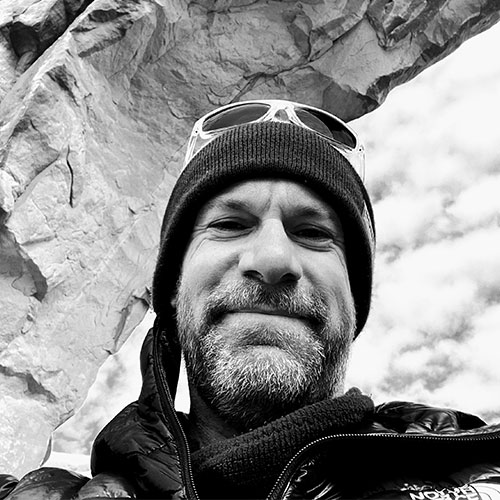
Erik Lambert is the founder of Bonfire Collective, a climbing/outdoor industry marketing agency, and a co-founder of Bluebird Backcountry, a human-powered ski area. He was Alpinist Magazine’s first digital editor, served as the American Alpine Club’s marketing and membership director from 2010–2015, and set routes back when Red Bull was a valid form of payment.
Routesetting and Collaboration Go Hand in Hand
By Foxman McCarthy-James
After attending the annual CWA Summits in Colorado and Utah, I was excited to travel to Pittsburgh. I’ve never attended the Summit outside of a major outdoor climbing hub, and I was curious to see how the move would impact the event. Knowing the effect unions had on the price of exhibiting, I wasn’t surprised that there was less representation from smaller hold companies, which was a disappointment from my biased perspective. The upside was a significantly more organized catering option than in previous years.
From a routesetting standpoint, there were significantly less offerings than in previous years. I was personally looking forward to Hayley Moran’s presentation on Siege the Southeast, which was taken off the schedule last minute. Hopefully we are able to hear from her and others next year in Portland.
Notably, there was a significant amount of owner and management content, which aligned with a recurring theme in the routesetting conversations: collaboration. Owners and routesetters have a historically fraught relationship, and this year’s CWA conversations seemed to center on how we can best work together in order to serve our communities and the sport we love.
Routesetting Roundtable: Working Toward a Common Goal
A staple of the Summit, the Routesetting Roundtable often draws a large audience, and this year’s session moderated by Heather Reynolds was no exception. The 80+ attendees formed a large circle and opened the session with a poll: Who has been setting for more than ten years? Less than three? Who feels that routesetting can be a career?
This last question set the tone for the session. Topics centered around sustainability, education, and quality control. Setters shared strategies for promoting health in a physically demanding job, with a focus on efficient rope skills and scheduling for recovery. When it came to education, Kenneth Cronin of Crag X shared his strategy for increasing gender diversity on his team by offering internships in pairs. I was personally gratified to see that most facilities represented in the room didn’t require setters to work for free or trade, continuing the trend of increased industry professionalization.
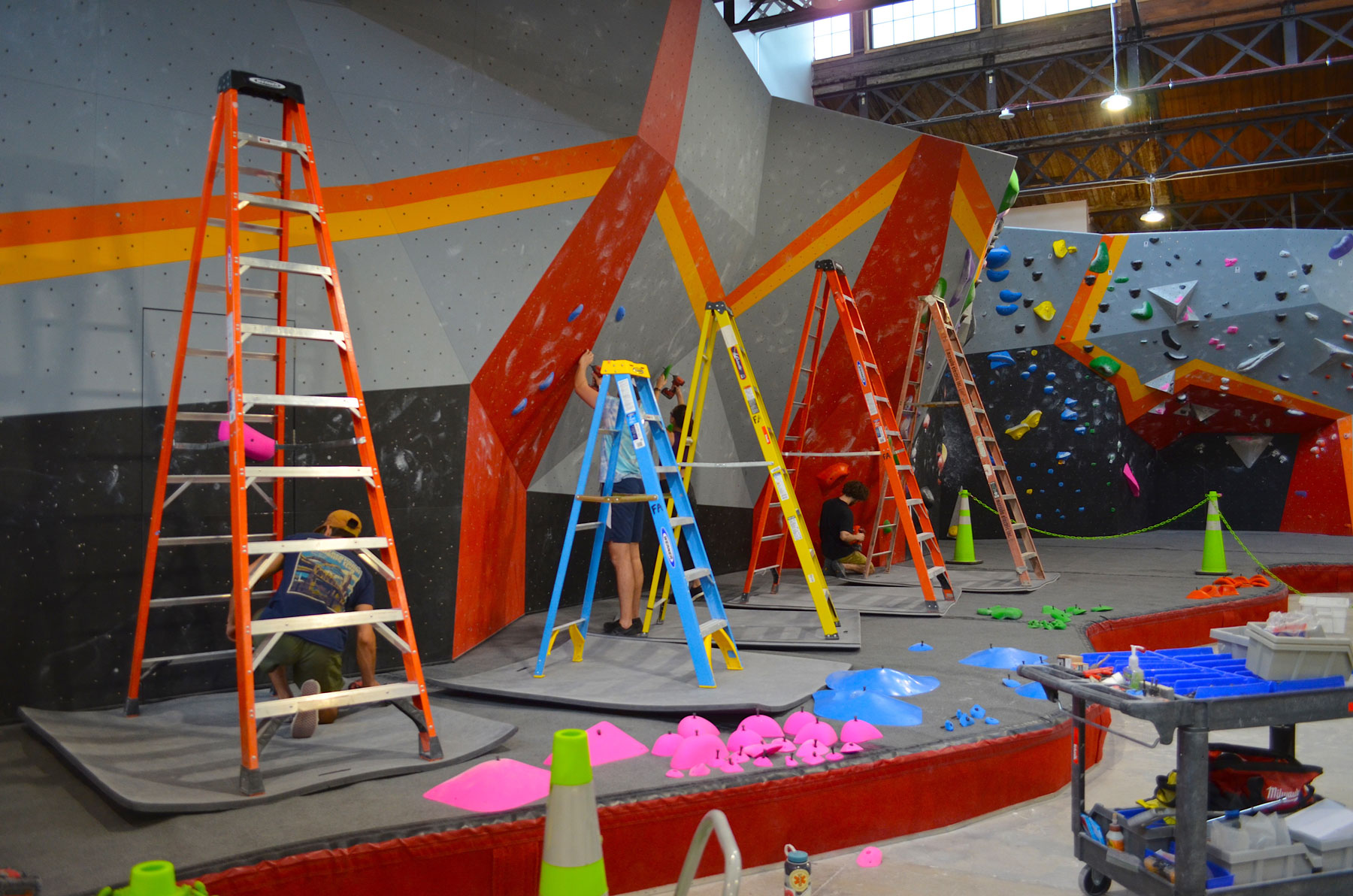
The evergreen topics of grading and customer feedback arose, sparking conversation about the best ways to gain meaningful feedback from our communities. Justin Wright of Edgeworks shared his three-prong approach to member feedback: paid routesetting observation shifts, scheduled member surveys, and third-party app analytics. We discussed the pros and cons of routesetters picking up coaching or front desk shifts, as well as adjusting setting quotas based on terrain and hold size.
I’d heard most of these topics discussed in previous years’ roundtables, or in any room with a critical mass of routesetting talent. What struck me this year was the focus on collaborating with gym ownership as a means for advocacy and decision making. Paul Jung, Director of Routesetting for The Cliffs, spoke about the importance of tying everything back to working toward a common goal. We all want what is best for our gyms.
Routesetting Committee Update: More Education Is on the Way
As a new member of the CWA Routesetting Committee, this session was the one I was most excited about. The panel was led by Garnet Moore (CWA) and consisted of Jackie Hueftle (Kilter), Paul Jung (The Cliffs), Alexandra Fox (First Ascent), Ward Byrum (Movement), Justin Wright (Edgeworks), Kyle Dontanville (Vertical Solutions/Proxy), Peter Zeidelhack (DAV), and myself. We began with the roll-out of the CWA Routesetting Guide, designed to provide standards and accountability to both routesetters and gym ownership. From defining roles and responsibilities to worker safety, the manual is a launching point for routesetting industry standards.
The focal point of the committee update, however, was the launch of a routesetting educational track designed to provide meaningful certifications to professional setters of all levels. The pilot of the CWA Intro to Routesetting clinic debuted at FA Station Square in the days preceding the Summit, taught by Kyle Dontanville and Alexandra Fox. A second clinic will follow at the Setter Summit at The Front SLC in June. White the Intro clinic targets aspiring routesetters and gym management interested in better understanding the routesetting departments, we are excited to begin developing courses designed for more experienced routesetters.
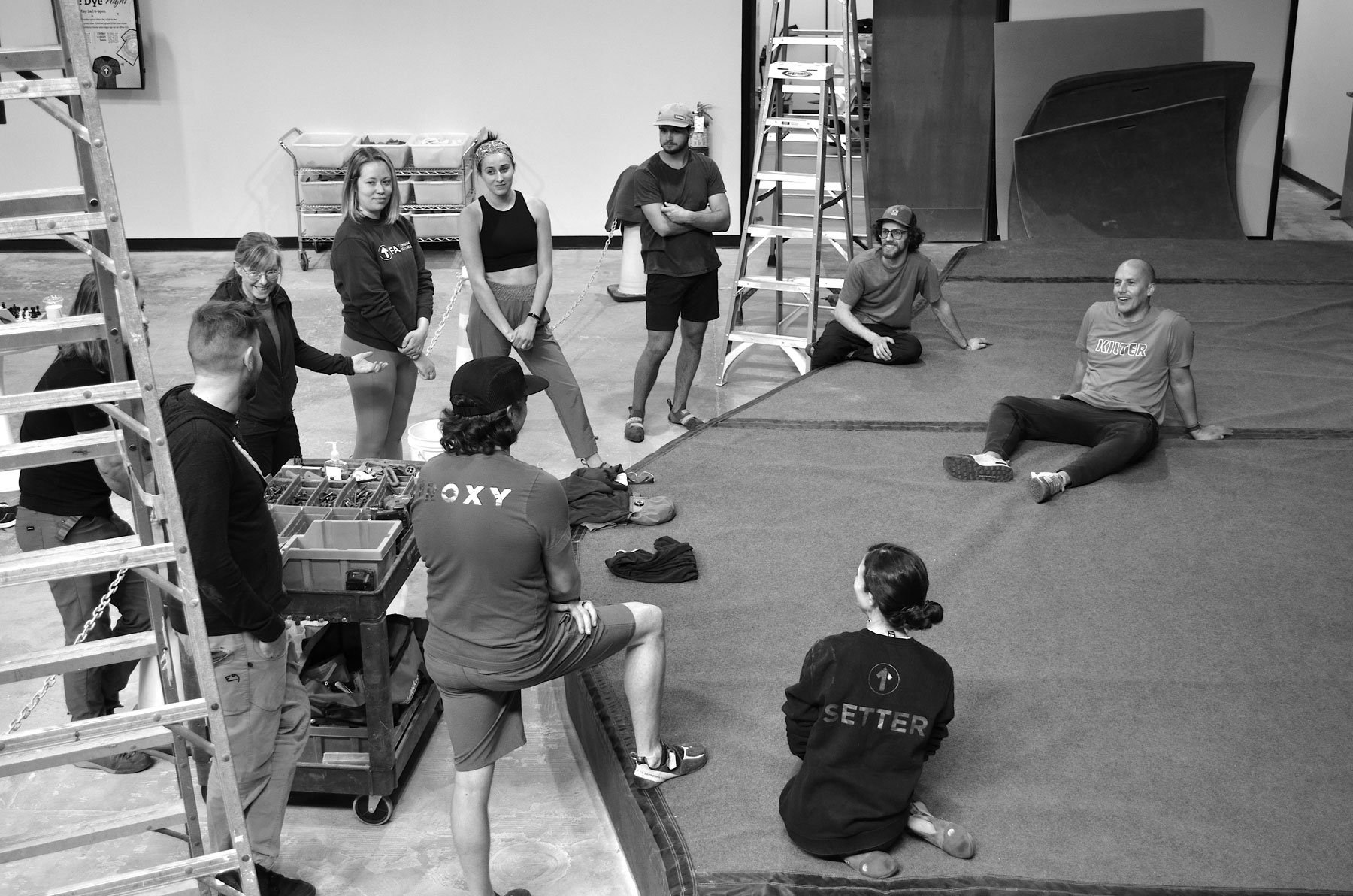
The majority of the questions from session attendees centered around accessibility. With a dearth of formal educational tracks, stakeholders in the room were keenly interested in the possibility of a future Provider track, akin to the CWA CWI Provider certification. While we have yet to develop a Provider track, the committee plans to develop these opportunities in conjunction with each course offered. We also discussed using online learning options to improve accessibility where possible. (The Intro course includes a pre-course online module, introducing terminology and concepts to supplement in-person learning.) One attendee raised the possibility of womxn’s and BIPOC courses.
For me, some of the most meaningful questions came outside the session. Experienced setters asked if there would be an option to be grandfathered in. Others expressed a desire for continuing education in movement for head setters who might be feeling burnt out. Overall, my takeaway is that while there is interest in a CWA educational track, those of us in the committee will have to earn buy-in from our colleagues.
Building a Routesetting Program: Starting From Scratch Is Hard
At last year’s CWA Summit, Justin Wright and I debuted our ongoing industry data project tracking routesetting workloads, pay bands, and safety practices across the country with Vortex Routesetting. While that project has garnered attention and continues to grow, we wanted to put together a presentation with more tangible offerings this year. As Head Setter for Alta Climbing and Alta Boulders in Arizona, I had the opportunity to build a routesetting program for two gyms simultaneously. Justin, as Director of Routesetting for Edgeworks in Seattle, is currently overseeing a sizable expansion. Personally, I would have loved to have had even a rough outline of what to expect when I first arrived at Alta. This presentation was an attempt to provide that outline, both for routesetters and ownership teams.
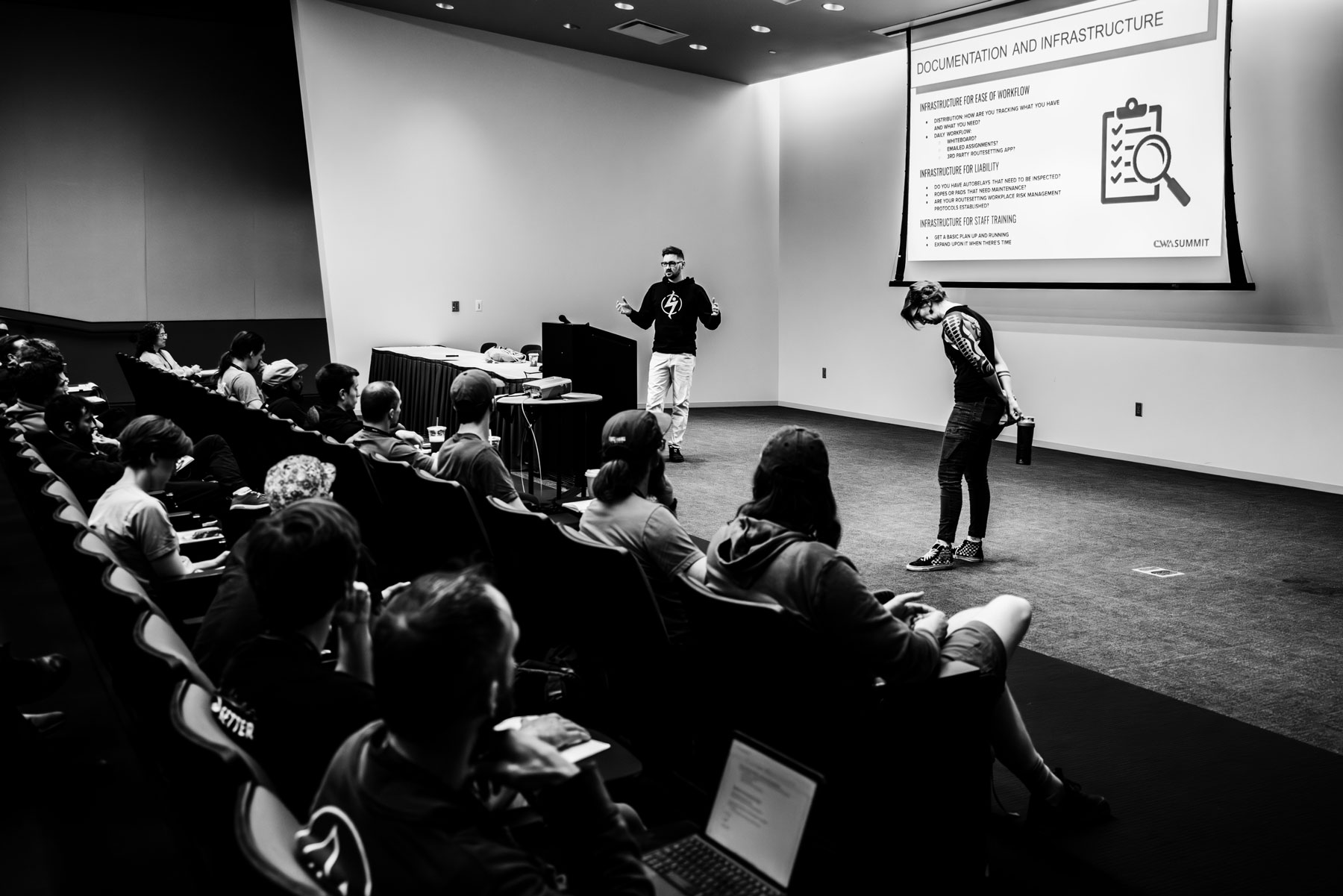
The first part of our presentation covered building a team from scratch, as I had to do at Alta. While that information might be valuable to routesetters who find themselves in my situation, most of the audience seemed more drawn to the second part, centered on strategies for expansion and development. How can we provide sustainable programs that attract and retain talent? What types of professional development are routesetters seeking? How can we make everything scalable? Each section of our presentation included a link to a PDF checklist that we hope can be a tool for head setters and owners as they build and expand their programs.
Modern Comp Setting: We Are All Learners
As Head Routesetter for High Point Climbing with his Level 4 USAC certification and 25+ championship level events under his belt, Blake Green has already earned a reputation for mentorship and education within the routesetting community. Knowing we were likely to sit with people we knew, Blake immediately reassigned us randomly to tables that would become our crew for a hypothetical comp. He then asked each table to choose a competition to set, ranging from a citizens competition to a Youth Divisionals event without a lift.
The entire session centered around empathy and communication. Rather than focus on the logistics for the competition, he encouraged us to think about the needs of stakeholders. Each crew was asked to evaluate the experience of all setters and assign roles aligned with optimal professional growth. Blake’s use of the term “learners” for the least experienced setters subtly emphasized that every role, from Chief to Assistant to Routesetter, was a Learning role. Chiefs were encouraged to make assignments based on each team member’s individual goals. I keep saying “encouraged” because no explicit directives were given. The hypothetical competitions were organized around mutual goal setting, not authoritative hierarchies. I thoroughly enjoyed it.
I always look forward to the CWA Summit as a way to connect with old friends, see some cool new holds, and take the temperature of the industry. While I would have liked more routesetting educational sessions to choose from, I feel that the emphasis put on education and communicating effectively and empathetically is a sign that our nascent industry is maturing. I look forward to seeing everyone at next year’s Summit in Portland.
About the Author
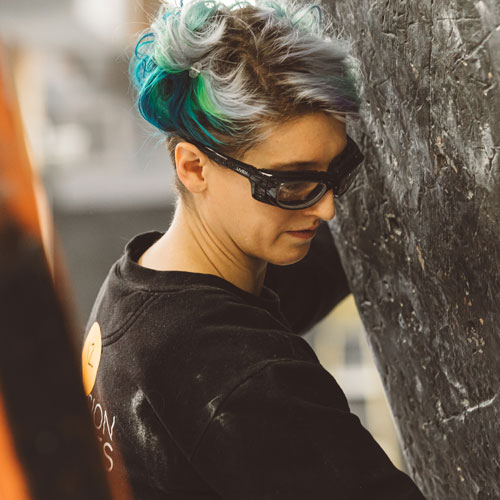
Born and raised in Boulder, Colorado, Foxman McCarthy-James began routesetting in 2015 in Boston while working as a professional violist, but fell in love and pivoted to set full-time with Brooklyn Boulders. Now as the head setter for Alta Climbing in Phoenix, Arizona, Foxman is focused on developing strategies to promote sustainability for career routesetters.
In 2021, Foxman and her colleague Justin Wright created Vortex Routesetting after years of travel and conversations led to a data project documenting routesetting workloads and salaries across the country. Vortex provides clinics and consulting for both climbing gyms and individual routesetters.
There’s Always Room for Improvement
By Gavin Heverly
This past week, I attended my…10th? 15th? CWA Summit. I’ve been attending the event off and on since its inception many moons ago, when it was just a couple vendors around a small indoor pool at a hotel in Boulder, CO. If the Summit is any indicator of the industry’s growth, which I believe it is, then we’ve literally and metaphorically come a long way from breathing chlorine around a small pool.
This year’s event took us all to the East, a massive conference palace in Pittsburgh, PA. Turns out all things climbing don’t revolve around the Mountain West! Vendors had big fancy booths, and hundreds of industry professionals were in attendance to see the keynote address by Kareemah Batts, which was displayed on a towering jumbotron so everyone could see. As someone who has been in the climbing industry for nearly two and a half decades, I was both impressed and a bit disappointed with what I saw and heard over the course of the Summit.
Let me explain…
We’ve Come a Long Way, and There’s a Ways to Go
My objective as an industry veteran and a consultant was to learn where the industry is at, what leaders and owners are dealing with, what problems they need to solve, how they are thinking about the future, and where they need help.
On the one hand, the amount of opportunity, growth, new companies and cash injection into the industry is beyond what I think any of us would have imagined 25 years ago. Light-up holds? Walls that move? Approach shoes that actually look cool? Presentations from people outside of our industry? Private Equity? Crazy!
On the other hand, I think our industry has a ways to go and a lot to learn in order to professionalize itself and catch up with other tangential industries in regards to strategy, human resources, sales tactics and more. Luckily, the CWA Summit provides an excellent platform for leaders in our industry to come together to address these shortfalls and collaborate on how to get better.
When you combine these two sides of the same coin, I think you get a narrative that indicates a lot of opportunity for all of us. Which is really exciting.
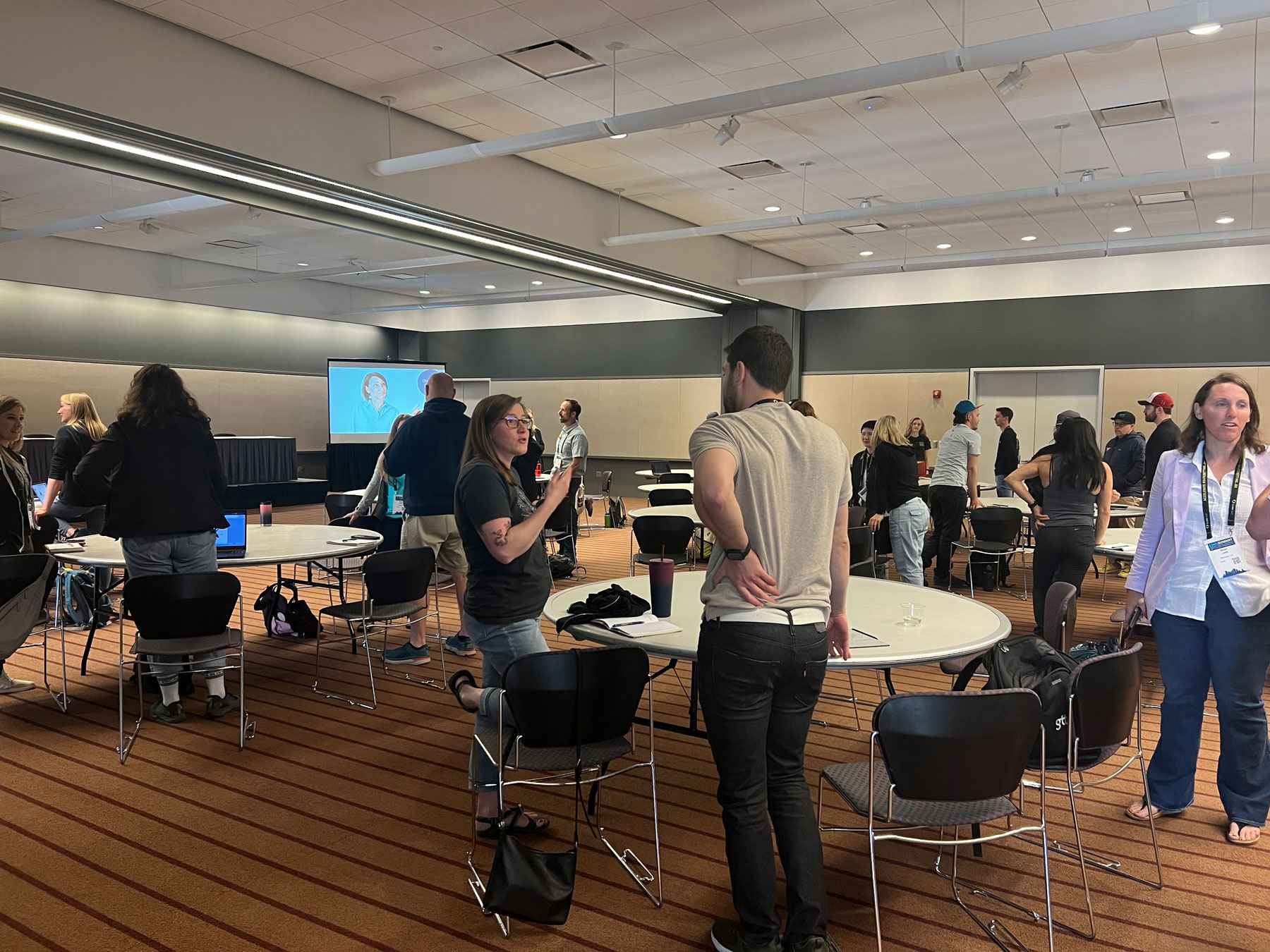
The Good and the Bad Will Scale With You
Some of the themes and topics that were apparent this year both in the sessions and on the exposition hall floor were:
- Technology and where it might take the industry: I saw continued innovation in the training wall space, with two new walls debuting at the tradeshow: the Treadwall with light-up holds in partnership with Kilter, which is more geared towards individual climbers, and the Nectar light-up rotating wall in partnership with Urban Plastix, which is larger in size and more geared toward commercial use. And there continues to be innovation in the point-of-sales space, with BETA, Approach and others offering new options for managing memberships, waivers and sales.
- Growth, how to achieve it, how to sustain it, and how to finance it: It seems like almost everyone was looking to expand their climbing gym footprint. On the flip side, when I spoke with many gym owners and leaders, it seemed like they were still experiencing considerable challenges with their existing operations. My consulting recommendation there is to slow down and make sure your core business is humming. Remember, the good AND THE BAD will scale with you!
- Managing culture in a changing world inside of a business and industry that is in flux and growing rapidly: Almost every session I attended and every person I talked to at some point mentioned how much harder it has been to manage culture, especially since 2020.
- Data, and how to better leverage it to grow and manage a business: Much of this discussion was surrounding membership sales and retention, but some presenters and attendees were also discussing demographic research, marketing data and more.
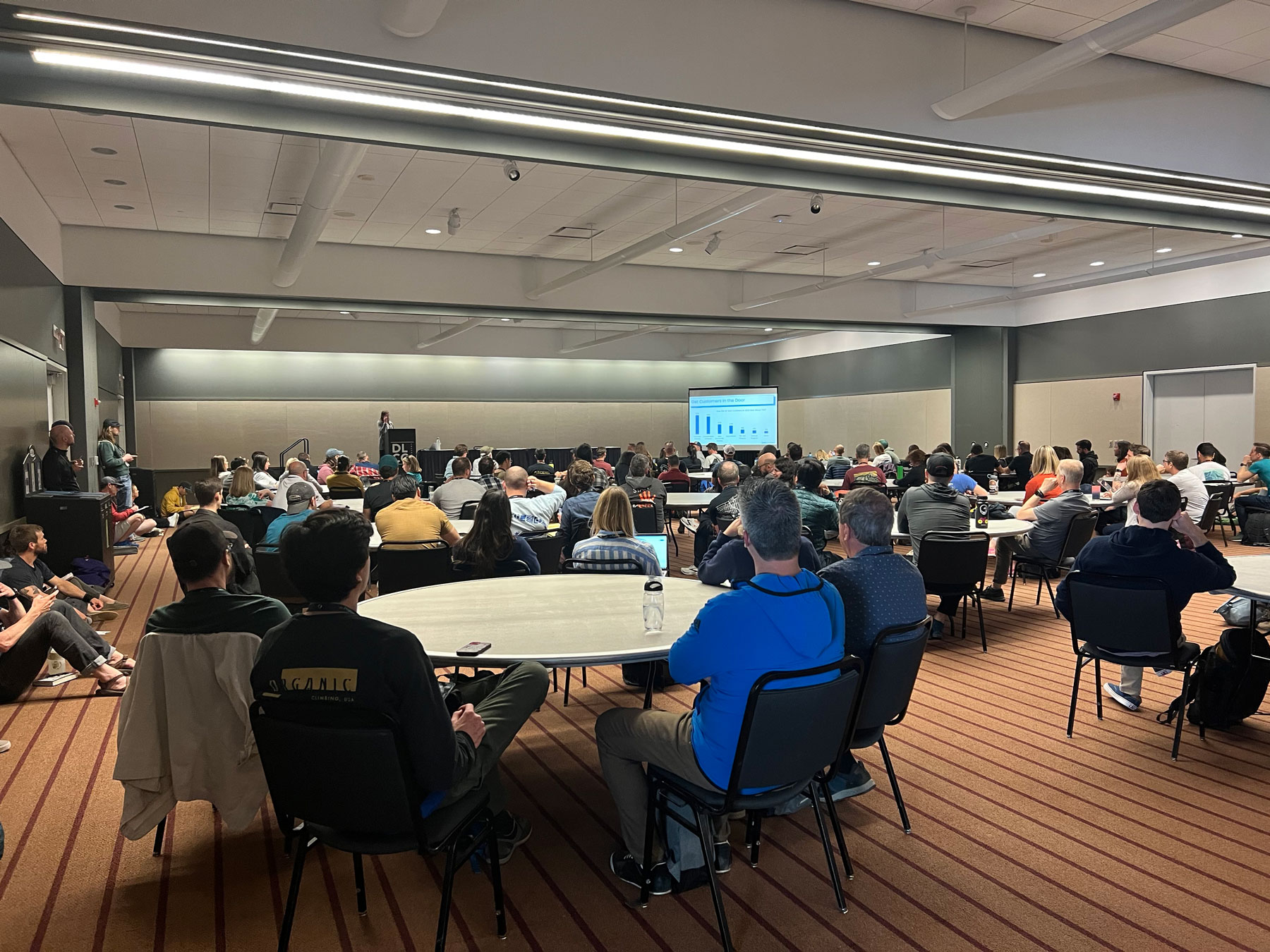
Look Beyond Our Small Corner of the Room
There’s always tons to take in at the CWA Summit, and everyone will walk away with their own applications from all the sessions and conversations. Here are a few takeaways I had this year:
- Gym owners and leaders should be open to and look heavily to best practices in other industries (retail, food service, fitness, tech): Doing so helps drive good decisions related to compensation strategy and culture, human resources implementation and execution, and member sales and retention strategies and tactics.
- The workforce is changing, and culture needs to adapt to meet new needs: Culture = values + behavior. It isn’t enough to simply have values; you have to exhibit them in how your organization operates. Pay transparency is coming—more and more states are requiring it—and your staff are talking about it whether you like it or not, so start managing the narrative now to drive trust. People want opportunities to grow.
- Tech is a top priority; climbing gyms lag in its adoption compared to traditional fitness gyms: If you want to compete for wallet share with other recreational and fitness brands, you should be considering how to leverage tech. Always keep an eye on what is happening in other spaces.
The above list is by no means insurmountable. I am hopeful for the future of the climbing gym industry, for what lay ahead, and for our ability to collectively wrestle the bear. After all, if there is any group of people who embraces a little type-2 fun in order to improve and achieve something fantastic, it’s for sure climbers.
About the Author
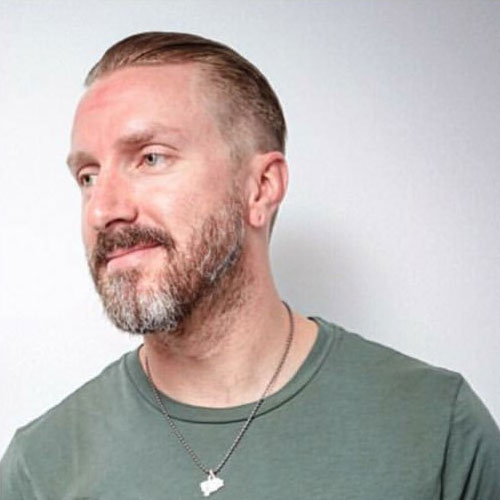
Gavin Heverly has been working in the climbing industry for over 20 years and is the founder of Rise Above Consulting. He has spent most of his life pursuing his passion for growth, climbing, fitness and adventure. That journey has allowed him to apply a unique set of skills and experiences in leadership, operations, team development, and scaling culture and strategy to a variety of real-world challenges and opportunities. Gavin is also a volunteer with a mountain search and rescue team and an avid climber.
Staff Retention Requires Empathetic Leadership
By Scott Rennak
Going into the educational seminars of this year’s CWA Summit, my hope was to glean effective operational tactics. I wanted to learn some actionable steps a gym manager could employ to improve business performance, and so I attended sessions on programming, membership, marketing, technology and routesetting. Indeed, each speaker did pass along many valuable tidbits.
However, what really resonated with me this year were not those tactics. Instead, I walked away seeing clearly that, across all areas of operation, our industry is embracing empathetic leadership as the cornerstone for excellence. It came back to that idea in every single session I attended—yes, dial in the operational details, but more importantly, spend serious effort cultivating your team. Make sure your business is a nurturing and welcoming environment. This is the path to retaining your staff, they all advised.
Staff retention, of course, is crucial to the long-term success of any business and has always been key for climbing gym businesses, both as an operational necessity and an extension of our shared value of community. But the presence of the topic during the sessions I attended does seem to be a sign of the times, and not just in the climbing industry. The pandemic shifted workplace cultures across the globe; for employees around the world, the pursuit of a high quality of life and mental well-being has had new expression and renewed importance. As business leaders, we can be a force for good here.
Values Are There to Be Put Into Practice
For me, the CWA Summit was a reminder that to attract and retain a good team requires empathy and collaboration with managers, building spaces where each team member feels heard and valued and their needs are met beyond simple compensation. Operationalizing this value in turn increases staff engagement, buy-in and longevity. It’s about spending the time to really listen and understand and offering flexibility wherever possible. It’s about investing in the largest asset (and expense) at your business: the people on your team.
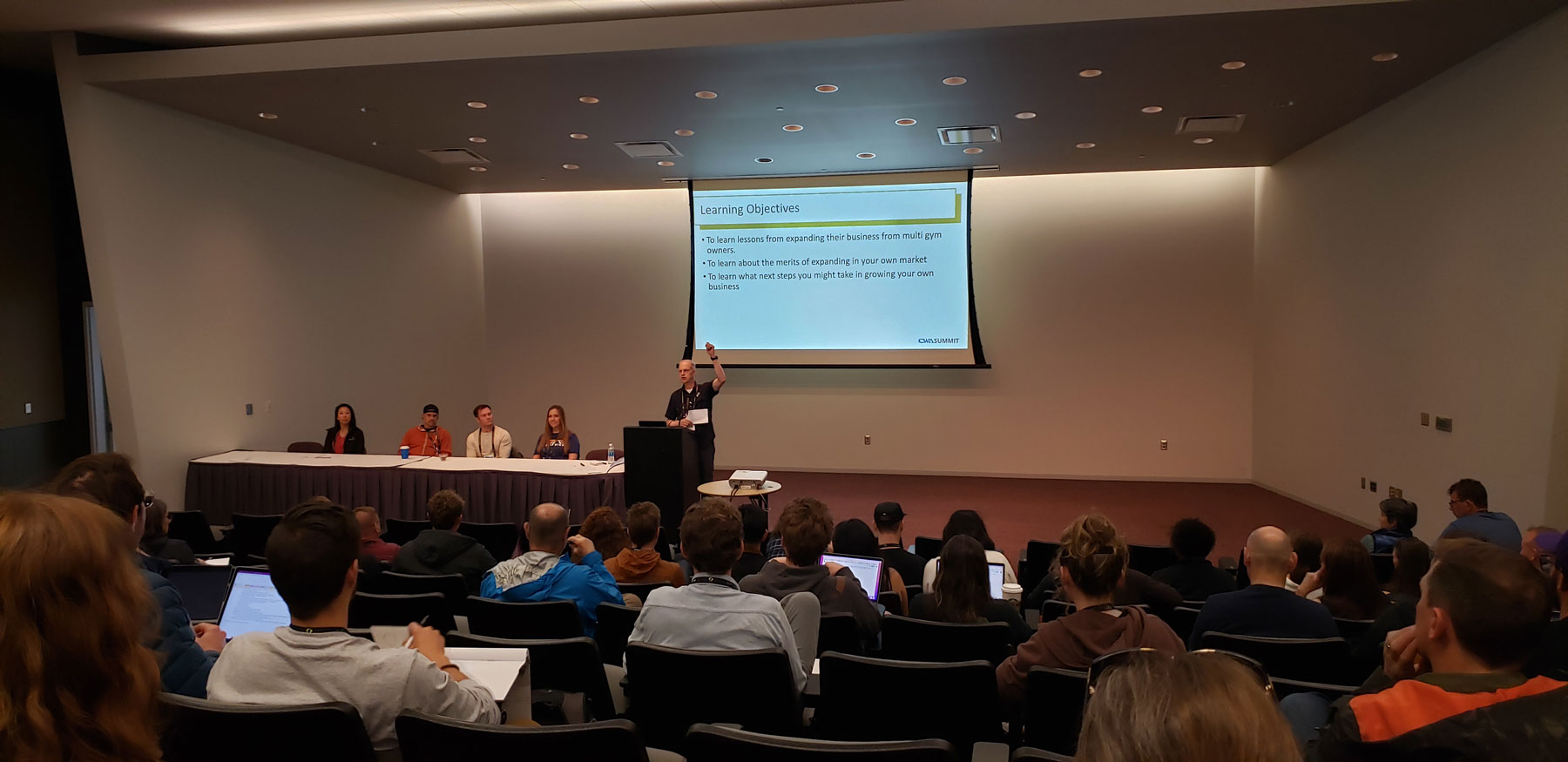
This culture of empathy starts at the top, and it needs anchoring values. “Improving lives through climbing” can be a rallying cry that unites staff and drives management decisions. So can “we take care of each other”. Equipped with values, together we then implement the systems to make them actionable, actively listening along the way to stay aligned. Feedback loops are so important to this process—taking the time to hear people’s suggestions, gripes, and simply how they are doing personally. This process also takes some degree of slack in the system, and a budget that accommodates this time and space. If some of this approach was a corner to be cut pre-Covid, it’s not anymore.
It was observed that, of course, this level of empathy takes emotional intelligence from the leaders. They need to be in touch with themselves, mindful of what is happening in their own lives and how it could affect their interactions and decisions. Being vulnerable and honest is a key component to building good teams.
I heard this idea, the importance of putting empathy into practice, over and over again—from front desk managers, who provide flexibility with scheduling and responsibilities so that staff have the energy and desire to stick around longer; from routesetting managers, who provide trainings, therapeutic services, and fun activities to help setters stay healthy, psyched and inspired; and from owners and facility managers, who provide career development opportunities across their management teams so they stick with the business as it grows.
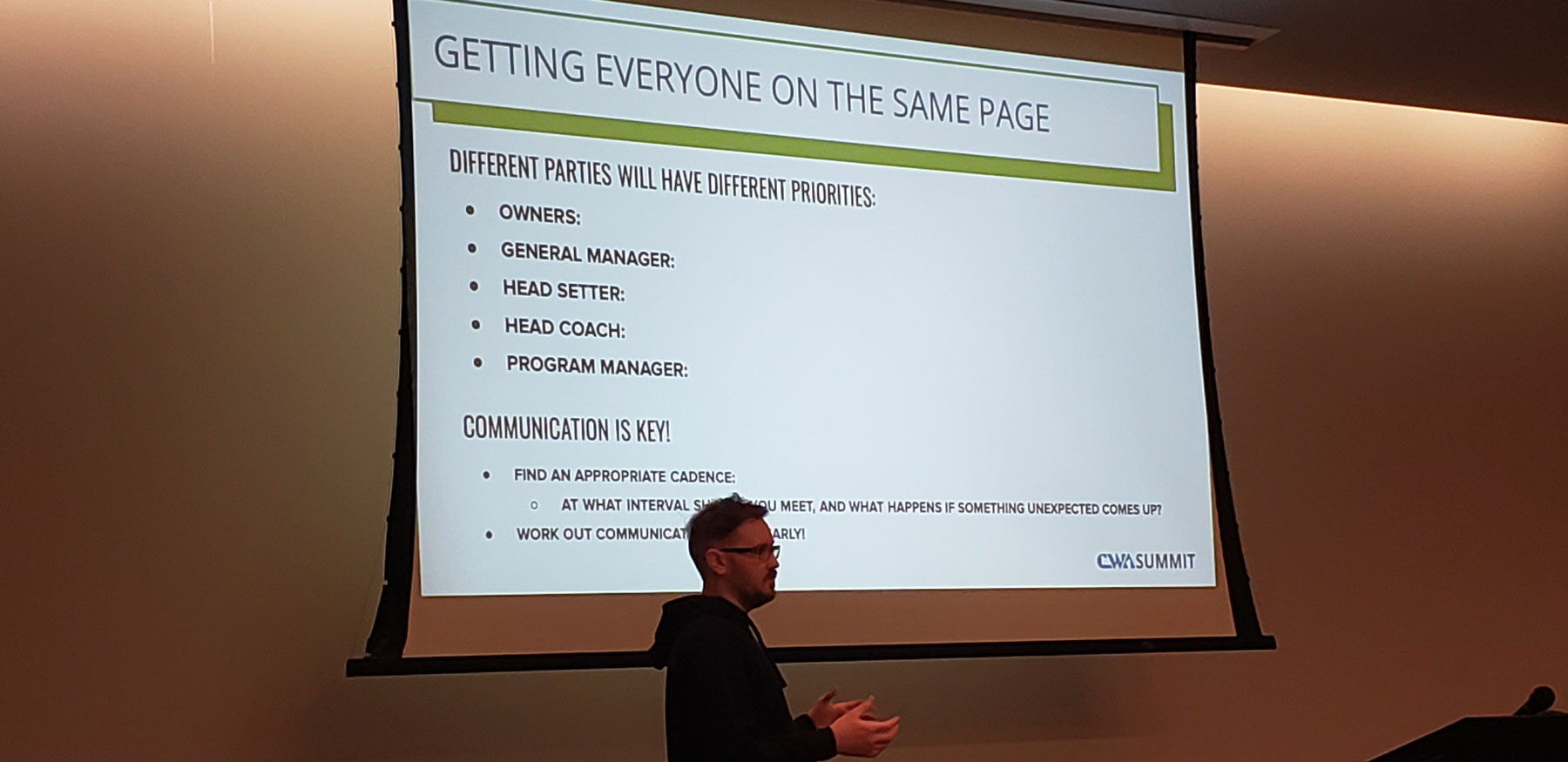
Empathy Is Good for Your Staff and Your Business
Some might say, “Duh, empathetic leadership has always been known to contribute to healthy workplaces.” They’re right. But I’d say not always, and not everywhere. As a kid of the ‘80s and gym worker of the ‘90s in the Midwest, this focus on mindfulness, self-care and empathy was not how I was raised, and I’m not alone. That nose-down, get-er-done, and no-complaints-along-the-way ethos still prevails today in some businesses. And while hard work has its place, without empathy as a compass it’s a bit like sprinting faster in the wrong direction.
At first glance, leadership empathy might seem like a luxurious expenditure—it can boil down to lots of time spent listening and in discussions. But when you consider the high cost of turnover, and the improved productivity when a staff member is motivated and engaged, the return on this investment becomes more obvious. And it simply helps the people in a workplace to feel happy and healthy—which, after all, is a primary reason our customers visit our climbing gyms in the first place.
Making this investment early is also smart business. I heard several speakers acknowledge that “problems multiply” as you scale your business; “fixing it later” is always harder and more expensive.
Some specific staff investments I heard:
- Embracing last-minute “personal days” by cultivating and incentivizing front desk and instructional teams that cover shifts for each other.
- Supporting your routesetters and coaches’ development by allowing travel to other gyms, scheduling clinics, and bringing in guest setters and coaches.
- Purchasing technology solutions that reduce staff frustrations, and using those solutions to make a team stronger, not smaller.
- Spending the time on team and individual meetings that increase collaboration.
The payoff for empathetic leadership is huge. When people feel valued and heard, they are more engaged and productive. They are happier and perform better, and the teams and customers they interact with feel that change. Investing in your people improves your culture, and your culture shapes your community. A thriving community is what most gyms strive to build, and so in my opinion it all starts with empathetic leadership. It will trickle down.
About the Author
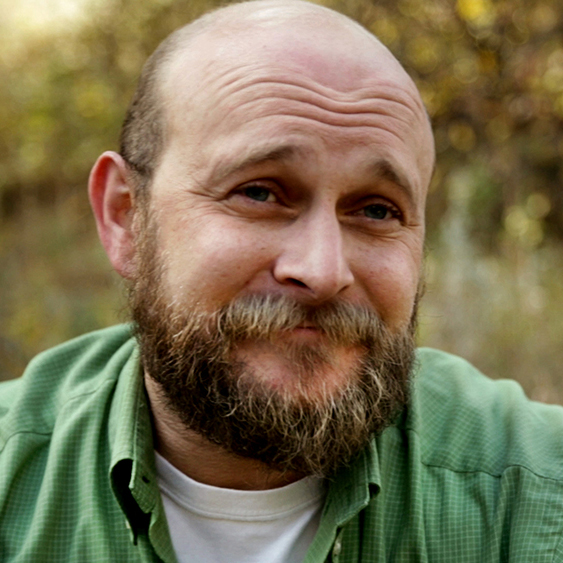
Scott Rennak has been promoting indoor climbing since 1997 when he bought Climb Time of Cincinnati and started what would become the American Bouldering Series. Since then, he has helped hundreds of small businesses grow, including climbing gyms and manufacturers. Scott is currently the owner/publisher of Climbing Business Journal and is available for projects through Reach Climbers. In his free time, he still scours nearby hills for fresh boulders, skis all year, and is a dedicated father to his two young children.

Climbing Business Journal is an independent news outlet dedicated to covering the indoor climbing industry. Here you will find the latest coverage of climbing industry news, gym developments, industry best practices, risk management, climbing competitions, youth coaching and routesetting. Have an article idea? CBJ loves to hear from readers like you!




